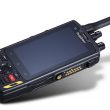Good thinking
Power utilities have been using wireless technology for automatic meter reading since at least the 1990s. An employee packing a handheld terminal can walk down a street taking reads without approaching the buildings. Even better, a meter reader with a mobile unit can drive down the street collecting usage data on the fly.
Today, some utilities are using RF technology to eliminate the meter reader’s visits entirely. “Smart meters” linked to fixed wireless networks transmit usage data as often as the utility needs it — once a month, once a day or even more.
Now, the combination of smart meters and wireless communications has spurred some electric utilities to start redefining the relationship between power provider and power consumer.
“You’re going to see, in the course of the next few years, a major change in the way that utilities and customers are able to interact with one another,” said Henry Jones, chief technology officer for SmartSynch in Jackson, Miss.
This year, Burbank Water and Power in Burbank, Calif., will embrace that change by using what SmartSynch says are the world’s first Wi-Fi-enabled smart meters. The public utility is building its Wi-Fi mesh network not only to read meters remotely, but also to implement programs that help customers consume power more efficiently.
Using frequent readings to monitor usage in a building over time, BWP will be able to identify buildings that are wasting energy — for example, by operating older, less efficient heating or air conditioning systems.
Replacing inefficient equipment will save customers money, and if enough of them do it, BWP won’t need to build a new power plant to meet out-of-control customer demand, said Fred Fletcher, assistant general manager, power supply, for BWP. “We have programs to help people determine energy efficiency and even rebates to help them pay for it.”
Fletcher also plans to make the smart meters interact with demand controllers — automated systems that commercial customers install to control lighting, air conditioning and other devices in order to manage their energy consumption. Through the Wi-Fi network, BWP could analyze power usage in various buildings and determine how to tone things down when high demand strains the grid. It could change thermostat settings by a couple of degrees, for example, or make other small adjustments remotely.
“Our goal here is to find a way that we could respond to times when we have to do unplanned emergency power reductions with as little pain as possible,” Fletcher said.
Wi-Fi radios integrated into SmartSynch’s meters will communicate over a fixed mesh network, initially using technology from Tropos Networks of Sunnyvale, Calif. BWP will own and operate the municipal network, using its fiber optic ring to backhaul data from the access points.
Because it’s putting the access points on rights-of-way along city streets, BWP’s network can provide bandwidth for mobile applications as well. Besides providing communications for the utility’s field personnel, the network could support applications for Burbank’s police and fire departments. “While those aren’t drivers for the business model, they certainly are drivers with regard to support for the project and its deployment,” Fletcher said.
BWP isn’t the first SmartSynch customer to use RF in conjunction with its smart meters. Two large utilities in the area, Southern California Edison and the Los Angeles Department of Water and Power, communicate with its meters over AT&T’s wireless data network.
Wi-Fi isn’t practical for BWP’s neighbors, which have much larger service areas, Jones said. “For Fred, for his 18 square miles, his top-end number, with all the meters and all the network, is around $20 million. That wouldn’t get you very far if you were trying to cover Los Angeles.”
But Wi-Fi is the best choice for BWP, Fletcher said. “It’s on all the time, and the cost of interrogation is not a function of how many times you access data.” Also, because BWP is designing the network and will own it, the utility can control its reliability, he said.
BWP expects to build out about 30% of its network infrastructure by July of this year, focusing first on commercial customers. By Jan. 1, 2009, officials hope they can use the system to implement time-of-day pricing, charging more for power during high-demand hours and less during off-peak hours, Fletcher said.
The utility hasn’t yet set a schedule for developing the rest of the network. “We want to do a lot of testing to see how this is going to work,” Fletcher explained. BWP is still weighing different strategies — for example, whether to expand its commercial installations before adding residential customers, or to extend the network to residences sooner.
Along with the uses already planned for the near term, Fletcher envisions applying the Wi-Fi network and smart meters in ways that he says are still under development. In one scenario, the meters would communicate with a display in the home or business, informing customers about details of their power usage in real time. “Consolidated Edison has proposed something like a magnet that could go on your refrigerator and show you what those things are,” he said.
While displays for customers loom on the horizon in Burbank, they’ve already arrived in some homes and small businesses in Louisville, Ky. Eventually, about 1800 customers will receive such displays as part of a power usage management pilot program conducted by Louisville Gas and Electric. The goal is to learn whether keeping LG&E customers informed about electric rates and their own consumption will spur them to use power more judiciously.
The pilot system will use smart meters from a variety of vendors and a wireless network developed by Trilliant of Redwood City, Calif. The mesh network does not use Wi-Fi technology. Instead, it uses technology based on the IEEE 802.15.4 standard for wireless personal area networks. This is the standard adopted by the ZigBee Alliance, an association of companies working to build low-power, wireless monitoring and control capabilities into everyday devices.
“Every device on the network becomes a node,” said Paul Karr, vice president of marketing at Trilliant. Devices that pass data along the wireless mesh could include programmable thermostats and smart switches in water heaters, pool pumps and other appliances, as well as the smart meters.
Outside the customer’s premises, the mesh passes data to a collector device linked to the utility’s backhaul network. “For example, if they’ve already invested in a Motorola private network, then we’ll simply use that as the backhaul from our collector devices,” Karr said.
In rural areas, Trilliant supplements the network with repeaters and uses radios with varying power levels. These help move data across gaps where there are no customers, and therefore no collectors.
For the pilot, the 1800 LG&E customers who receive the smart meters are divided into four groups. Since February, 150 volunteer customers have been participating in a full-blown responsive pricing program; their electric rates vary based on the time of day, and they jump to a higher-than-normal level on the rare occasions when demand for power reaches critical levels.
LG&E has given these customers in-home displays and programmable thermostats and water heater controls. The display indicates how much power the customer currently is using and employs color codes to indicate the price in effect at the moment. Customers can install the displays wherever they like.
“Sitting across the room, even, based on the color, you know the price of electricity,” said Greg Fergason, demand side management program manager for LG&E. “You also have a pretty good idea of, ‘Am I using a moderate amount or a whole lot?’”
Customers can program their thermostats and water heaters to adjust to rate changes. “I might tell my thermostat that when that price goes to the high price to bump it up to, say 75°,” Fergason said, describing a customer managing an air conditioner in the summer. “And those 80 hours a year when I hit a critical price, go ahead and bump it up to 77°.”
The rest of the customers in the program will not see their rates fluctuate with the time of day or peak usage. But all of them will get smart meters. One hundred fifty also will get in-home displays and programmable thermostats; 150 will get programmable thermostats and water heater controls but no displays; and 100 will get displays only. The balance — a control group — will get smart meters but no in-home devices.
The main question LG&E wants to answer is whether giving customers more information and greater control over energy usage will encourage them to use less power or shift usage to periods of lower demand, Fergason said.
LG&E plans to run the pilot for three years, evaluating benefits and customer satisfaction along the way. But it’s already making plans to extend the network to more customers. “I think our company will look very hard at a full-scale deployment well before the three-year pilot’s up,” Fergason said.
According to an announcement from the Kentucky Public Service Commission, LG&E implemented the pilot to comply with a December 2006 order that requires the state’s electric utilities to implement smart metering pilot programs. But Fergason said the utility also wants to get customers actively involved in boosting energy efficiency.
“We see this as a great way to provide them with the information they need and the tools to make a fairly significant difference.”












